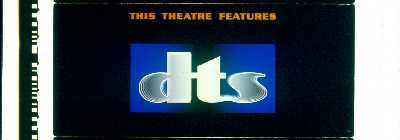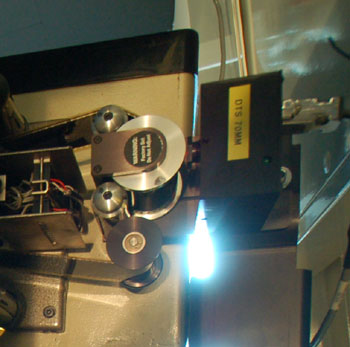|
| |
What is DTS 70mm?
Requirements to play the DTS' Special Venue 70mm 6-track
format
aka. "DTS 'Special Venue' for Beginners"
|
Read more
at
in70mm.com
The 70mm Newsletter
|
|
Written
by: Peter Fearn, DTS Service
Engineer & Paul Rayton |
Date:
15 January 2007 |
What is DTS 70mm?
|
Films in DTS
70mm
|
 The DTS 70mm digital sound process for motion pictures is designed to play
in cinemas that are equipped for 70mm projection and 6-track stereo. It is
a dual system in that the digital audio data is recorded on CD-ROM discs.
A special time code is printed on the 70mm motion picture film and is
located outside the sprocket holes. DTS 70mm prints do not have
conventional magnetic striping, so, analog sound cannot be used. For
fail-safe operation, a second DTS playback unit is required. The DTS 70mm digital sound process for motion pictures is designed to play
in cinemas that are equipped for 70mm projection and 6-track stereo. It is
a dual system in that the digital audio data is recorded on CD-ROM discs.
A special time code is printed on the 70mm motion picture film and is
located outside the sprocket holes. DTS 70mm prints do not have
conventional magnetic striping, so, analog sound cannot be used. For
fail-safe operation, a second DTS playback unit is required.
DTS sound for 70mm and 35mm film prints is
designated as "5.1" channels, and is delivered to speakers in the cinema
like this: 3 channels behind the screen (left, center, and right), plus
left surround, right surround, and the ".1" channel, which is
technical-speak for the subwoofer (a/k/a sub-bass) channel, a
low-frequency-only speaker that gives films the BOOM sound modern
audiences seem to need.
It's given the ".1" designation because it isn't
truly a complete full-range channel. The ".1" channel is limited in range, hence the 6 discrete
channels you are actually working with are described as "5.1".
|
My Fair Lady
Independence Day
Vertigo
Star Wars
The Lost World
Titanic
Tomorrow Never Dies
Mulan
Armageddon
Godzilla
A Trip To Mars (S)
Mercedes Car Commercial
CineSpace 70
Blackadder Back & Forth
The Good Ship Citizen
Reach for the Sky
Advert for Blackadder Back & Forth
Dinosaur
Fanny's Wedding
Pearl Harbour
Lawrence of Arabia
A Year Along the Abandoned Road
70mm DATASAT Titles
|
What is DTS 70mm Special Venue?
|
Films in
DTS 70mm Special Venue
|
 The
70mm reader on a DP75 The
70mm reader on a DP75
DTS "Special Venue" is a term used to identify any film format that
is not the standard release format of 35mm 4 perforations per frame. DTS audio for special venue installations is 6 full-range channels (as opposed to the 5 + 1 partial-range
channel described above).
The channels are named from 1 to 6 as they can be placed anywhere in the
cinema.
There is
not a specific layout. Most will be 5 channels behind the screen: left, left
extra, center, right extra, and right (once upon a time, known
simply as channels 1, 2, 3, 4, and 5), plus a single surround channel
(formerly "channel 6") that feeds all surround speakers the same
information.
However, some may choose to have a top
centre, and stereo surrounds. Theme park rides are mixed specifically for
the environment and speaker placement can be anywhere.
To play "special venue" DTS, you of course must already have the two
"inner" sound channels available, including the amplifiers and the
speakers. Most contemporary films are not mixed to use these channels,
so many cinemas today are not equipped with them. So, first of all, you
must make sure they are available -- and working.
For getting the DTS "special venue" sound to these proper speakers, you
need some way to re-direct the sound channels from the DTS processor
into the proper pre-amplifiers and thence into the appropriate
auditorium speakers.
There are various ways to accomplish this, and the specifics vary
somewhat depending on what type of DTS processor you have. There are
several DTS processors out there now, including -- among others -- the
DTS-6, DTS-6AD, and the DTS-XD10.
The DTS-6 cannot be used as Special Venue it is the DTS-6D that can be
upgraded.
|
Patton
Playtime
Hello, Dolly!
Lord Jim
The Sound of Music
It's A Mad, Mad, Mad, Mad World
Those Magnificent Men in Their Flying Machines
The Agony and the Ecstacy
Doctor Dollittle
The Miracle of Todd-AO
To Be Alive
South Pacific
The March of Todd-AO
Cleopatra
STAR!
West Side Story
70mm DATASAT Titles
|
|
More
in 70mm reading:
What is DTS 70mm
Presented in 70mm with
digital DATASAT sound (Formerly DTS)
Internet link:
|
The simplest method is to simply make up an "adapter wire", which you
can plug into the output of your DTS processor, and which re-directs the
sound to the appropriate pre-amps, etc. This is cheap to prepare, but
requires time to install (and/or remove) whenever you change formats.
And you will need to consult with DTS and/or your theatre's audio
technician to get the pin assignments for the sound coming out of your
processor. Care must be taken in this, as you can end up with screen
dialogue sound coming out of surround speakers, or other undesirable
effects.
If you have the newest systems from DTS (the XD-10), sound is held on
the system's hard drive (the XD10 does 6.0 as well as 5.1 and 8 channel.
This is all included in the Audio license). In that system, sound may be taken out in the
AES-EBU digital format and routed into the theatre system digitally. To
do this definitely requires a consultation with DTS and your theatre's
audio technician, and some aspects of that will depend on what other
equipment is installed in your cinema.
There is also at least one extra chip (from DTS) which must be installed in
the processor. This chip is essential to allow the audio for the extra
channels (channels 2 and 4) to be treated as full range audio, and be routed
appropriately. This chip must be obtained from DTS as it is programmed by
them to work with their processor. It's not all that expensive, but it is
necessary. And again, that's why you need to have DTS (or a certified
engineer) come over at least once to modify the equipment for such sound
playback.
There are ways to make relay boards that can be manually switched
between DTS modes, but such relay boards are not available "ready to
order", but DTS may be able to help you.
It's relatively easy to do all this to get the original sound mixes to
play. But it has to be done correctly, or sound will be in the wrong
places in your auditorium!
|
|
How do I upgrade to DTS Special Venue?
|
|
To upgrade to
DTS 70mm Special Venue all that is needed is an extra APTX I/C
(integrated circuit). This is placed in the spare socket (bottom row,
middle socket) on the D536 audio board.
Unfortunately the D536 needs to be Rev D, the later Rev H cards do not
use APTX I/Cs to decode DTS. The APTX I/C went obsolete and the board
was redesigned.
There are a few other things you need to have for Special Venue to work:
1. V1.46 time code software, and
2. AQRM_RC or latter, unit software (the latest version is V2.54.40).
3. A good idea would be to have the SV setup disc to check channel
assignments.
Unfortunately DTS do not do a Special Venue test film, but the Special
Venue setup disc will
only self play in a Special Venue 6D player.
Below is the upgrade kit, it has all you need to convert a 5.1 6D to a
6.0 6DSV. Unfortunately it assumes you have a rev D, D536 audio card:
|
|
|
9005E18800A |
Upgrade Kit, DTS-6D SV (special venue) 545.00 |
|
1606000200 |
IC,4 to 1
compression, (APTX100ED) |
|
6060001000 |
CD-ROM,test,6.0 S.V.,Dscrete 6-ch set-up
|
|
7210000100 |
Promo,DTS tweaker,"DTS Listen |
|
90500TCR00V1.46 |
EPROM, programmed,
256K, D422 U14 (TC) |
|
9050AQRM04V2.54.20 |
EPROM, programmed,
4M, AQRM |
|
9301DT6D02 |
Manual, DTS-6D-SV
Special venue
|
|
|
Types of files on DTS Special Venue Discs
|
|
There are 3 different types of file on the disc for Special venue.
Basically it is down to if there
is time code on the film. If there is then a 70mm reader head is required
and all should work.
If there is not time code on the film and it is less than one disc in length
(only on CDrom not two) then the unit can reed SMPTE from the
tachometer.
If there is no time code on the film and the sound needs to be put on two
discs, then an E175 (Tach to time code converter) is needed. You input the
serial number of the film into the E175 and it automatically goes to the
next reel number as the Tach signal increments.
|
|
|
|
Go: back
- top - back issues
- news index
Updated
22-01-25 |
|
|

 The DTS 70mm digital sound process for motion pictures is designed to play
in cinemas that are equipped for 70mm projection and 6-track stereo. It is
a dual system in that the digital audio data is recorded on CD-ROM discs.
A special time code is printed on the 70mm motion picture film and is
located outside the sprocket holes. DTS 70mm prints do not have
conventional magnetic striping, so, analog sound cannot be used. For
fail-safe operation, a second DTS playback unit is required.
The DTS 70mm digital sound process for motion pictures is designed to play
in cinemas that are equipped for 70mm projection and 6-track stereo. It is
a dual system in that the digital audio data is recorded on CD-ROM discs.
A special time code is printed on the 70mm motion picture film and is
located outside the sprocket holes. DTS 70mm prints do not have
conventional magnetic striping, so, analog sound cannot be used. For
fail-safe operation, a second DTS playback unit is required. The
70mm reader on a DP75
The
70mm reader on a DP75